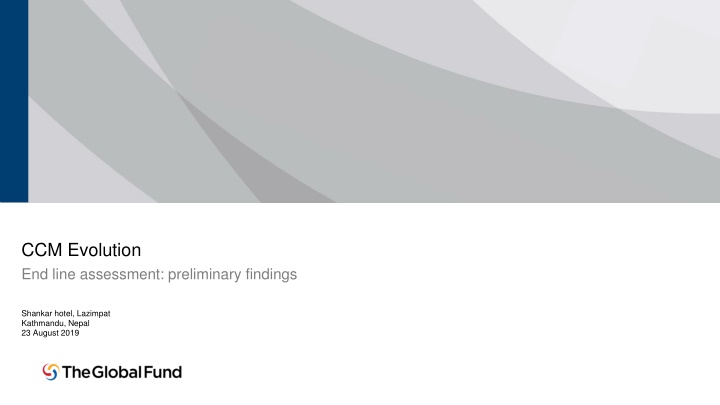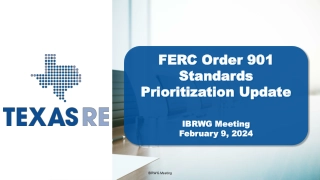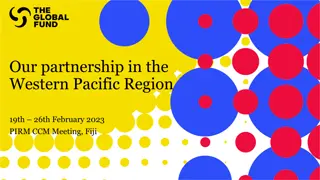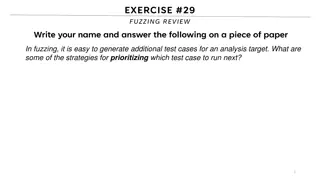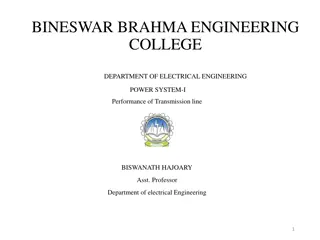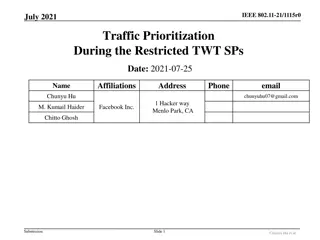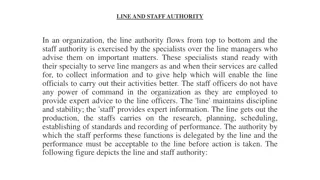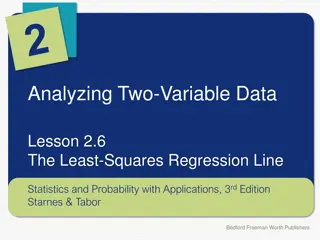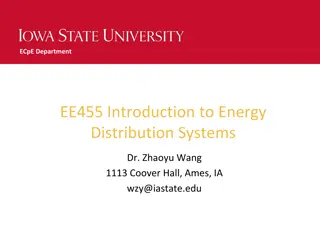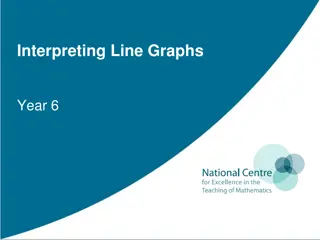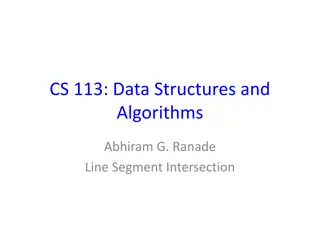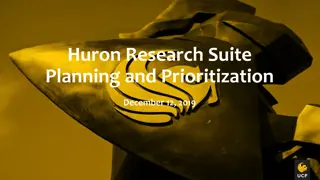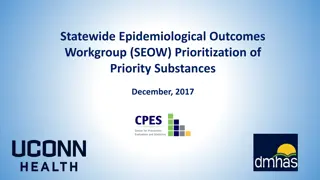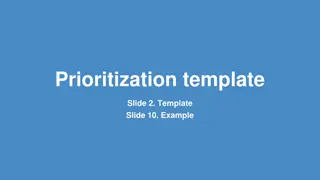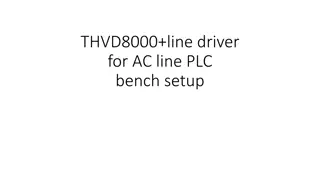CCM Evolution End Line Assessment: Understanding Progress and Prioritization
The CCM Evolution End Line Assessment focuses on evaluating project progress against baseline indicators and identifying factors hindering or contributing to progress. Key findings and upcoming activities for September to December 2019 are discussed, emphasizing the importance of comparing progress with the baseline. Strengthening oversight, repositioning the CCM within the national landscape, enhancing member engagement, and equipping CCM Secretariats for effective support are critical elements analyzed in the assessment.
Download Presentation

Please find below an Image/Link to download the presentation.
The content on the website is provided AS IS for your information and personal use only. It may not be sold, licensed, or shared on other websites without obtaining consent from the author.If you encounter any issues during the download, it is possible that the publisher has removed the file from their server.
You are allowed to download the files provided on this website for personal or commercial use, subject to the condition that they are used lawfully. All files are the property of their respective owners.
The content on the website is provided AS IS for your information and personal use only. It may not be sold, licensed, or shared on other websites without obtaining consent from the author.
E N D
Presentation Transcript
CCM Evolution End line assessment: preliminary findings Shankar hotel, Lazimpat Kathmandu, Nepal 23 August 2019
Agenda Items Introduction 1. Key findings Preliminary results 2. Discussion on prioritization of activities for September- December 2019 3. 2
Introduction 1 3
Introducing the End Line Assessment The End Line Assessment mostly focus on evaluating progress with respect to the baseline in terms of: Progress against maturity levels Progress towards achievement of project indicators Additional factors contributing towards or impeding progress Factors contributing towards, or impeding progress will also be analyzed and documented in a report. 4
How is the End Line Tool different from the Baseline The Stage 2 interview section is focused on CCM Evolution project indicators Questions under Stage 2 have been reviewed to reflect lessons learned and results/bottlenecks identified during the baseline and implementation Unpacked existing indicators and reviewed thresholds per area to guarantee consistency with scoring Unpacked Indicators Revision of Stage 2 Emphasis on comparing progress (or lack thereof) with respect to the baseline assessment This is to be captured in the comments section under each evolution area Greater emphasis on requesting specific evidence for assessment results Evidence should speak to the Evolution time frame, and should be provided with accompanying links for each document Specificity of Evidence Comparing Progress 5
Analysis: Strengthening the So what? and Why elements Strategic Vision: Reflecting on the maturity path observed for the CCM, what will it take for the Global Fund governance model to remain relevant, responsive and effective through CCMs in the particular context given the grants priorities? What are the key elements that will ensure the oversight function is tailored to the grants priorities and aligned to relevant national systems and processes? Oversight How should the CCM be repositioned within the national landscape to contribute to a sustainable response? Linkages What are the key elements that will ensure enhanced engagement of CCM members amongst themselves and across sectors e.g. CS being meaningfully represented. Engagement What are the key elements that will ensure CCM Secretariats are well-equipped to provide the necessary support (technical and administrative) to CCMs? CCM Functioning What have been or could be the catalyzers/hindering factors in various contexts (Standard, transitioning, COE, grant size and focus, governance maturity, leadership and engagement). Overall Results 6
Key Findings Oversight (1) Indicator Response Baseline Indicator O.1 Existence of an oversight body Engaged ind 1.b Working towards functional Indicator O.2 The oversight body is composed of CCM members (including KP, PLWD representatives) and non- members Strategic ind 1.b Working towards functional Indicator O.3 The oversight body has an adequate set of skills, expertise or lived experience to ensure strategic oversight. Core skills include: (i) financial management, (ii) disease-specific expertise, (iii) procurement and supply management, (iv) program management, (v) health financing, (vi) human rights, and (vii)risk management. Indicator 0.4 Existence of an Updated Oversight Plan that includes information on the cycle of activities (particularly site visits, interactions with PRs, and communications with the GF), specifics about prioritized indicators, data collection and analysis provisons, tools and budgets. Strategic ind 1.b Working towards functional Engaged Ind 1.a Functional Indicator 0.5 The CCM Secretariat is equipped with an Oversight Officer who possesses the adequate skills to support the oversight function Engaged Ind 1.c Working towards functional Indicator 0.6 The Oversight Officer is trained on data for decision making, risk management and on understanding of co-financing data. Functional Indicator 0.7 The Oversight Committee meets at least quarterly, as evidenced by meeting minutes. Engaged Ind 1.d Working towards functional Indicator 0.8 The Oversight Committee reviews the performance of each PR at the time of the submission of Progress Update and Disbursement Requests (PU/DR) to the Global Fund Functional Ind 1.h Working towards functional Indicator 0.9 The CCM OC meets/interacts quarterly on key performance topics and follows up with each PR. Engaged Ind 2.a Working towards functional 8 Indicator 0.10 The CCM conducts quarterly site visits, which are documented. Engaged Ind 3.b Working towards functional
Key Findings Oversight (2) Indicator Response Baseline Indicator 0.11 The feedback/information obtained from site visits informs CCM discussions and decisions. Functional Ind 3.b Working towards functional Indicator 0.12 The CCM keeps track of co-financing commitments/requirements Engaged Ind 7.a Functional Indicator 0.13 Based on data-driven discussions with the PR and other stakeholders, the oversight committee recommends actions to be considered by the CCM for decision making Functional Ind 4.a Working towards functional Indicator 0.14 Based on data-driven discussions with the PR and other stakeholders, actions recommended inform decisions of the CCM, which are included in a plan(with deadlines, stakeholders in charge and deliverables). Engaged Ind 4.a Working towards functional Indicator 0.15 Based on data-driven discussions with the PR and other stakeholders, CCM actions are followed up on all the way to resolution Engaged ind 4.a Working towards functional Indicator 0.16 The Oversight Committee meeting minutes show that reprogramming is being investigated Indicator 0.17 Dated meeting minutes, reports or work plans provide evidence of frequent data-driven dialogue between the oversight committee and the PR (including, where feasible, interactions with the CT, LFA and FA) Indicator 0.18 Dated meeting minutes, reports or work plans provide evidence of follow-up with each PR after the data-driven dialogue Working towards functional Ind 5 a Working towards functional Engaged Ind 2.a Working towards functional Functional Ind 2.a Working towards functional Indicator 0.19 The CCM participates actively (by providing technical input and contributing to discussions) in disease program reviews Functional ind 1i Working towards functional Indicator 0.20 The CCM implements risk oversight processes via relevant routines and structures. Functional Ind 6.a Working towards functional 9 Indicator 0.21 The Oversight Function has been strengthened with the appropriate tools, resources and skills Engaged
Summary Key findings - From working towards functional/functional, the oversight has moved towards the maturity level of functional to engaged/strategic in a very short period (6 months) Achievements - Formation of Oversight body with different expertise skills including KPs and PLWDs, CCM members and non CCM members - Recruitment of Oversight officer with adequate skills to support oversight - Development of an oversight plan - Regular meetings and fields visits - Data driven discussion with the PR and SRs have occured 10
Summary Key findings Ways forward for improvement - Review and analysis of performance of grant implementation with PR - OC recommendation to CCM members - Follow-up with PR on implementation of recommendations - Share with CCM, site visit findings and follow up on action plan - Additional training of Oversight officer on data analysis, risks management and co-financing data - CCM to implement risk management 11
Oversight - Factors Factors supporting - Additional TA - Recuitment of oversight officer (1rst June) - Additional resources for field visit, OC meeting - Oversight strengthening plan Factors impeding - Late disbursement of funds - No CCM meeting was organised due to the delay in funds disbursement - Timing of the assessment is too early - OC members full time official (the functionality of OC to be monitored) 12
Key Findings Linkages (1) Indicator Response Baseline Indicator L.1 Existence of a stakeholder mapping of relevant national coordination bodies and other stakeholders. Indicator L.2 CCM framework documents have been revised to formalize linkages with other health sector bodies. ind 1.a Working towards functional Functional Ind 1.c Working towards functional Functional Indicator L.3 A MoU or other documented agreement has been established between the CCM and National Health Structures to share information, communicate results, conduct strategic planning, or use data for decision-making. Indicator L.4 The CCM is joining efforts with other stakeholders to realize co-financing commitments and strengthen overall financing Functional Ind 3.b Functional Ind 1.b Working towards functional Engaged Indicator L.5 Existence of an action plan to implement coordination and communication activities with other national coordination bodies Ind 1.b Working towards functional Engaged Indicator L.6 Execution of an action plan on coordination and communication activities with other national coordination bodies Ind 1.b Working towards functional Engaged Indicator L.7 Existence of a documented strategy on how to engage with the government to support the realization of commitments made for co-financing Functional Ind 2.a Functional Indicator L.8 Implementation of a documented strategy on how to engage with the government to strengthen domestic resource mobilization for the three diseases and health systems. Indicator L.9 The main CCM functions and governance principles have been integrated in existing platforms and the principles of the GF (inclusiveness, transparency, good governance practices) are respected by this alternative body. functional Ind 2.a Functional Ind 4.b Working towards functional Functional 13
Summary of Key findings - Linkages Achievements - Coordination with other keystakeholders to secure co-financing and strengthen overall financing - Existence and execution of an action plan to implement coordination and communication with other national coordination bodies (TWGs, Provincial level) Ways forward for improvement - Revision of CCM documentation to formalise linkages with other health bodies - Implementation of a documented strategy on how to engage with the government to strengthen domestic resource mobilization for the three diseases and health systems - Main CCM functions and governance principles integrated in existing platforms and the principles of the GF (inclusiveness, transparency, good governance practices) 14
Linkages - Factors Factors supporting - Additional TA to conduct linkages assessment (March 2019) - Recognition and Support from key stakeholders including government (central, and provincial levels) and external donors Factors impeding - As recommended by TA, lower priority at that time - Insufficient financial ressources (e.g. for provincial level) - Staffing readjustement at provincial level 15
Key Findings Engagement (1) Indicator Response Baseline Indicator E.1 No single CCM sector can achieve quorum on its own Engaged Ind 1.f Functional Indicator E.2 CCM Female representation (including members and alternates) is at least 50% Functional Ind 1.c Functional Indicator E.3 National Civil Society Sector representation comprises at least 40% of the CCM membership Strategic Ind 1.d Functional Indicator E.4 Existence of procedures in place to replace members whose performance is unsatisfactory Ind 2.d Working towards functional Strategic Indicator E.5 Implementation of procedures in place to replace members whose performance is unsatisfactory Ind 2.d Working towards functional Strategic Indicator E.6 All CCM members and alternates have attended e-Learning trainings during the last six months. Ind 2.c Working towards functional Functional Indicator E.7 Quorum was achieved in all CCM meetings (ordinary and extraordinary) held during the January - July 2019 period. Strategic Ind 2.a Not assessed Indicator E.8 All CCM constituencies have complete documentation (which is publicly available - except in cases where information is highly sensitive with regards to key population representatives) on the transparent and inclusive process of selection/election of their representatives. Strategic Ind 1.a Not assessed 16
Key Findings Engagement (2) Indicator Response Baseline Indicator E.9 The Ministries in charge of budget and planning are effectively engaged in the CCM. (Effective engagement includes attendance, meaningful contribution during CCM meetings, involvement in key CCM processes (Funding Request Preparation, oversight activities, etc.) Indicator E.10 Presence and effective engagement of a CCM member (or members) with experience or training in RSSH (particularly Community Systems and Responses ) Functional Ind 2.e Functional Ind 1.a Working towards functional Engaged Indicator E.11 All CCM constituencies have communication plans Functional Ind 3.a Functional Indicator E.12 CCM composition analysis and available epidemiologic information show aligned representation of KAP and PLWD. Strategic Ind 1.b functional Indicator E.13 Existence of an MoU or other document evidencing the engagement between the CCM CS members and their constituency members Ind 3.b Working towards Functional Engaged Indicator E.14 The CCM Executive Committee includes membership of PLWD or KAP representatives. Ind 2.b Working towards Functional Strategic Indicator E.15 PLWD or KAP representatives who are members of the Executive Committee have an active participation (i.e. they provide technical input and contribution to discussions) Ind 2.b Working towards Functional Strategic 17
Summary of Key findings - Engagement Achievements - Different sectors representation - CSO representation - Existence and implementation of procedures to replace CCM members with unsatisfactory performance - Quorum achieved in all CCM meeting - Transparent and inclusive process for the selection/election of constituencies - CCM member with experience in RSSH - Aligned representation of KPs and PLWDs with epidemiologic data - Documentation on CS CCM members engagement and their consituencies - Executive committee include KPs or PLWDs with active participation Ways forward for improvement - - - Increase female representation Support ministry of finance for active engagement Support and encourage CCM members to take e-learning courses 18
Engagement - Factors Factors supporting - TA from APCASO to support constituencies engagement (April to December 19) - Financial resources were dedicated for constituencies engagement - Pro-activeness of consituencies and support from regional network (e.g MSM/TG, APCOM is supprting) - Strong support from CCM secretariat and Executive comittee Factors impeding - None to mention but language barriers/diversity have to be considered 19
Key Findings Functioning (1) Indicator Response Baseline Indicator F.1 All CCM members, alternates and secretariat staff have received training about the CoI Management Policy Ind 7.a Working towards functional Strategic Indicator F.2 All CCM members, alternates and secretariat staff have received training about the CoC Ind 7.a Working towards functional Functional Indicator F.3 The CCM has comprehensive operating procedures and TORs for all committees/working groups Engaged Ind 1.a Functional Indicator F.4 The CCM has updated its Conflict of Interest Management Policy Strategic Ind 6.b Functional Ind 6.a Working towards functional Indicator F.5 The CCM has adopted and endorsed the Code of Ethical Conduct for CCM members Functional Indicator F.6 All CCM members, alternates and secretariat staff have signed the annual CoC compliance declarations Functional Indicator F.7 The Eligibility and Performance Assessment (EPA) Improvement Plan is updated on a regular basis. Ind 4.d Working towards functional Engaged Ind 4.d Working towards functional Indicator F.8 The CCM Contacts are updated on a regular basis. Engaged Indicator F.9 All CCM members, alternates and secretariat staff have signed the annual CoI Management compliance declaration Strategic Ind 7.b Functional 20 Indicator F.10 Existence of an Ethics focal point (who must be a CCM member) or a small Ethics Committee (ideally not more than three members).
Key Findings Functioning (2) Indicator Indicator F.11 Existence of a costed CCM work plan which includes activities funded by other donors and national government Indicator F.12 All CCM members have participated in the three tiers of the CCM Orientation Program managed by the GF Response Baseline Ind 2.a Working towards functional Engaged Functional Ind 3.a Functional Indicator F.13 All CCM alternates have participated in the three tiers of the CCM Orientation Program managed by the GF Functional Ind 3.a Functional Indicator F.14 The CoI Management Policy is applied consistently to all CCM members, alternates and secretariat staff. Indicator F.15 The CoC is applied consistently to all CCM members, alternates and secretariat staff . Engaged Ind 6.b Functional Ind 6.a Working towards Functional Ind 4.a Working towards functional Functional Indicator F.16 The CCM assesses annually the overall CCM Secretariat Performance. Engaged Indicator F.17 In the context of CCM Funding, the annual work plan and financial reports are submitted to the GF (FPM, CCM Hub) on-time. Strategic Ind 4.c Functional Indicator F.18 All agendas CCM meetings (plenary and Oversight Committee) of the last 12 months were circulated to all CCM members/alternates and GF Secretariat at least 7 calendar days before the meeting. Indicator F.19 All CCM meeting minutes (plenary and Oversight Committee) of the last 12 months were circulated to all CCM members/alternates and GF Secretariat at most 7 calendar days after the meeting. Strategic Ind 4.b Functional Engaged Ind 4.b Functional 21
Key Findings Functioning (3) Indicator Response Baseline Indicator F.20 All CCM meeting minutes in the past 12 months include evidence of the application of procedures to prevent, manage and mitigate CoI (especially members recusing from discussions in which they may have potential CoI) Strategic Ind 9.a Functional Indicator F.21 The CCM has an endorsed communications plan Engaged Ind 5.a Functional Indicator F.22 The CCM communications plan has been Implemented in a timely manner (no major activity has more than 3 months of delay). Engaged Ind 5.a Functional Indicator F.23 All CCM Executive Committee members have recieived training in leadership topics or have completed the Executive Committee Module of the CCM Orientation Program. Functional Ind 3.b Functional 22
Summary of Key findings - Functionning Achievements - All CCM members trained on COI - ROB revised and endorsed - COI policy updated - All CCM members have signed COI - COI policy applied to all CCM members - EPA improvement plan was updated in July 2019 - CCM member s contact list updated in August 2019 - Existence of CCM workplan - CCM secretariat performance assess annually - CCM timely reporting on CCM budget expenses and workplan - CCM agenda circulated 7 days before the meeting and CCM minutes circulated within 14 days after the meeting - Communication plan updated in June 2019 23 -
Summary of Key findings Functionning (2) Ways forward for improvement - CoC implementation to be formalised with endorsement by CCM, training signature of CoC compliance declaration - CCM members and alternate who have not received CCM orientation should be trained - Executive committee members to take the Executive training module 24
Functioning - Factors Factors supporting - Support from CCM hub and CT for CCM orientation (March 2019) - Commitment of new CCM coordinator - Support from CCM executive committee and CCM - Support from CCM evolution push CCM to engage more Factors impeding - CoC is a new policy - CCM member availabilty (full time employment) - Late funds disbursement (change of FA) 25
Overall results What have been the catalyser or hindering factors Catalyser factors - Commitment of CCM secretariat and CCM - Additional staffing of CCM secretariat with adequate skill to support CCM - Additional financial resources to strenghten oversight, support constituencies engagement - Active engagement and participation of CSOs and governement Hindering factor - Late disbursement of funds which led to delay in implementation in particular for oversight 26
Discussion on prioritization of activities for September-December 2019 3 27
CCM strengthening work plan - Review of the work plan and prioritization of the activities for the period September to December 2019 Nepal/Document/End Line assessment/Nepal_ValidatedWorkPlan.xlsx 28
Proposed Process for Post-mission work What By whom Participate in a post-mission debrief with the CCM Hub and Country Team representatives. Consultants, in coordination with TA providers, CCM Hub and CT focal points Submitting the completed End Line Assessment Tool, validated documentation to serve as evidence for assessment findings and results, and a brief report using the online form provided by the Global Fund. Consultants, in coordination with TA providers and the CCM Hub focal points 29
Thank you! 30 30
